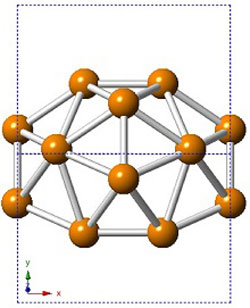| Mar 06, 2014 |
New findings on 2D boron crystals overturn previous assumptions
|
|
(Nanowerk News) “Boron is in many ways an analog of carbon,” says Xiang-Feng Zhou, Oganov’s postdoc at Stony Brook and also an Associate Professor at Nankai University in Tianjin, China. “Its nanostructures—nanoparticles, nanotubes, and two-dimensional structures—have attracted a lot of interest in the hopes of replicating, or even surpassing, the unique properties and diversity of carbon nanostructures. We discovered the structure of two-dimensional boron crystals, which is relevant to electronic applications and to understanding boron nanostructures. Our findings ("Semimetallic Two-Dimensional Boron Allotrope with Massless Dirac Fermions") overturn the assumptions and predictions of numerous previous studies.”
|
![Projections of 2 × 2 × 1 supercell of Pmmn-boron structure along [001] and [100] directions](id34663_1.jpg) |
| Projections of 2 × 2 × 1 supercell of Pmmn-boron structure along [001] and [100] directions.
|
|
Earlier work had concluded that two-dimensional boron will adopt the geometry of flat alpha sheets (structures composed of triangular and hexagonal atom patterns) or their analogs. These findings were used to construct boron nanotubes and nanoparticles with unique properties, such as high mechanical strength and tunable electronic conductivity.
|
|
“We found that the alpha sheet is massively unstable; this casts doubt on previous models of boron nanostructures,” Oganov says. “In particular, we discovered that flat monolayer structures of boron are extremely unstable, and the actual structures have finite thickness. This result will likely lead to a revision of structural models of boron nanoparticles and nanotubes. In particular, it is possible that hollow, fullerene-like structures will be unstable for boron.”
|
|
Oganov says the newly discovered two-dimensional boron structure possesses properties superior to those of graphene. “Within the 2D boron structure, electrons travel at speeds comparable to the speed of light, and behave as if they were massless; in some directions, the electrons travel faster than they do in graphene. This can be very advantageous for future electronic devices.”
|
|
While velocity does not depend on direction in graphene, the new boron structure exhibits directional dependence. In the slowest direction, the elections travel 38% slower in boron than in graphene. But in the perpendicular direction, the elections travel 34% faster in boron. This is the property that could be of value for electronic applications.
|
 |
| The Projection (Top view) of Pmmn-boron along [001] direction.
|
|
The findings were made possible by the structure prediction code USPEX (Universal Structure Predictor: Evolutionary Xrystallography) that was developed by Oganov and his lab. USPEX weds a powerful, global optimization algorithm with quantum mechanics and is used by more than 1600 scientists around the world.
|
|
The researchers next plan to explore the structure of boron nanoparticles; they believe prior conclusions in the field will have to be reassessed. Like all sound scientific inquiry, Xiang-Feng says, “This work raises more questions than answers. How do we experimentally prepare the two-dimensional structures of boron, given the high chemical reactivity of the element? While previous structural models were incorrect, how does this affect the structures of boron nanoparticles and nanotubes, and their electronic properties? This research sets the stage for a new wave of investigations into the physics and chemistry of boron-based materials and confirms the power of the USPEX method.”
|
![Projections of 2 × 2 × 1 supercell of Pmmn-boron structure along [001] and [100] directions](id34663_1.jpg)

